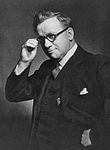1935 Parliamentary leadership elections
|
|
|||||||||||||||||||||||||
|---|---|---|---|---|---|---|---|---|---|---|---|---|---|---|---|---|---|---|---|---|---|---|---|---|---|
|
|||||||||||||||||||||||||
|
|||||||||||||||||||||||||
|
|||||||||||||||||||||||||
The 1935 Labour Party leadership election took place on 26 November 1935 when Herbert Morrison and Arthur Greenwood challenged Clement Attlee, the incumbent party leader of only one month and one day. Attlee, previously the party's Deputy Leader, had been appointed as an interim leader the previous month when George Lansbury resigned and the general election was looming.
With the Labour Party now having three times as many MPs, both Morrison and Greenwood stood in the annual election for leader, feeling that Attlee's appointment had only been intended as an interim measure. Morrison had not been an MP at the time of the October appointment, whilst Greenwood had declined to offer himself as a candidate then because he was strongly associated with trade union leaders such as Ernest Bevin, who were widely regarded as the reasons for forcing Lansbury to resign, a move that the vast majority of Labour MPs opposed.
The first round of the contest took place on 26 November 1935:
As the lowest-placed candidate, Greenwood was eliminated from the race.
The second contest took place on 3 December:
With a clear majority, Attlee retained the party leadership.
Herbert Morrison later claimed that he was denied the leadership of the Labour Party in the 1935 election by the votes of Labour MPs who were members of New Welcome Lodge. Morrison's backer Hugh Dalton made similar claims, and went further than Morrison by claiming to have been shown the summons for the meeting at which the voting was decided. Dalton believed that the members of New Welcome Lodge backed Arthur Greenwood, who was a member of the lodge, and then backed Clement Attlee in order to block Morrison. Greenwood was elected to replace Attlee as Deputy Leader.
...
Wikipedia



